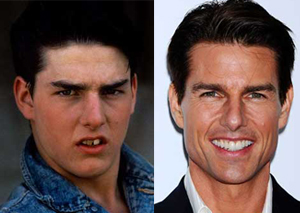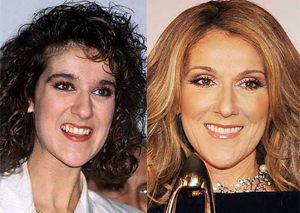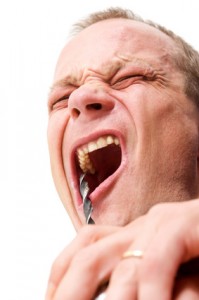 Okay, I understand getting to the dentist when you have an emergency can sometimes be hard. And, yes I realize that it’s awfully tempting to try and fix the problem yourself. But, there are just some things you should not do at home. This brings us to this weeks blog post. The WORST home remedies for dental problems.
Putting garlic against a sore tooth…. Besides making you smell bad, garlic is very potent and can irritate or burn soft tissues around the tooth causing even more pain and sensitivity.
Shaving down a sharp tooth with tools from around the house… Besides the fact that you are putting something that has seen more dirty surfaces than I’d care to mention directly into your mouth, you are putting yourself at risk for damaging the tooth more or slipping and causing damage to your cheeks and gums.
Using crazy glue to fix a broken natural tooth... Yes, I know people say the same stuff that’s in super glue is the same stuff used to seal battlefield wounds, and they’d be correct. However, the stuff used to seal battlefield wounds are made specifically to seal battlefield wounds. Using superglue to fix a tooth most likely will result in 1: You super gluing your finger to your lip, cheek, tooth or some variation of the aforementioned. Or 2: Pain from a tooth with a freshly injured dental nerve being assaulted by a brand of material that was not meant to see the inside of your mouth or to fix broken teeth. Trust me, its not pretty….
Whitening your teeth with lemon juice and baking soda… This one, although its gotten a lot of popularity throughout the years, is just not healthy for your teeth. Mixing an abrasive and an acid together and then scrubbing it on your teeth can cause abrasion to your gums while also removing and/or damaging the enamel on your teeth.
And lastly, searching through your medicine cabinet and finding a left over prescription from those wisdom teeth you (or someone you know) had extracted about ten years ago… Its not a mystery that taking old, expired or another persons prescription medications is a bad idea. Taking one or two remaining capsules of an antibiotic is not only ineffective, it can also help promote bacterial resistance to antibiotics. Also, taking prescription medications that were not prescribed to you can put you right in the middle of an adverse or even allergic reaction to a drug that no one knows you are taking. So if you are having a problem call your dentist or doctor first before resorting to whats left over in the medicine cabinet. Also, whenever you are prescribed medication once you have finished the prescription if there are any tablets remaining they should be disposed of.
So, I’m not saying there are not some things that you can do at home in a pinch to get you by until you can see your dentist. But, in an emergency situation, first and foremost, call your dentist and see when they can see you for an appointment and tell them your emergency. Your dentist will suggest the best way to get you comfortable and safely treated!]]>
Okay, I understand getting to the dentist when you have an emergency can sometimes be hard. And, yes I realize that it’s awfully tempting to try and fix the problem yourself. But, there are just some things you should not do at home. This brings us to this weeks blog post. The WORST home remedies for dental problems.
Putting garlic against a sore tooth…. Besides making you smell bad, garlic is very potent and can irritate or burn soft tissues around the tooth causing even more pain and sensitivity.
Shaving down a sharp tooth with tools from around the house… Besides the fact that you are putting something that has seen more dirty surfaces than I’d care to mention directly into your mouth, you are putting yourself at risk for damaging the tooth more or slipping and causing damage to your cheeks and gums.
Using crazy glue to fix a broken natural tooth... Yes, I know people say the same stuff that’s in super glue is the same stuff used to seal battlefield wounds, and they’d be correct. However, the stuff used to seal battlefield wounds are made specifically to seal battlefield wounds. Using superglue to fix a tooth most likely will result in 1: You super gluing your finger to your lip, cheek, tooth or some variation of the aforementioned. Or 2: Pain from a tooth with a freshly injured dental nerve being assaulted by a brand of material that was not meant to see the inside of your mouth or to fix broken teeth. Trust me, its not pretty….
Whitening your teeth with lemon juice and baking soda… This one, although its gotten a lot of popularity throughout the years, is just not healthy for your teeth. Mixing an abrasive and an acid together and then scrubbing it on your teeth can cause abrasion to your gums while also removing and/or damaging the enamel on your teeth.
And lastly, searching through your medicine cabinet and finding a left over prescription from those wisdom teeth you (or someone you know) had extracted about ten years ago… Its not a mystery that taking old, expired or another persons prescription medications is a bad idea. Taking one or two remaining capsules of an antibiotic is not only ineffective, it can also help promote bacterial resistance to antibiotics. Also, taking prescription medications that were not prescribed to you can put you right in the middle of an adverse or even allergic reaction to a drug that no one knows you are taking. So if you are having a problem call your dentist or doctor first before resorting to whats left over in the medicine cabinet. Also, whenever you are prescribed medication once you have finished the prescription if there are any tablets remaining they should be disposed of.
So, I’m not saying there are not some things that you can do at home in a pinch to get you by until you can see your dentist. But, in an emergency situation, first and foremost, call your dentist and see when they can see you for an appointment and tell them your emergency. Your dentist will suggest the best way to get you comfortable and safely treated!]]>
Posts
 1. Celebrity Smile Makeovers
2. The Seven Myths of Teeth Whitening
3. Teeth Whitening: How White Is Too White?
4. Are Teeth Whitening Kiosks at the Mall Safe?
5. No Time for Teeth Whitening? 4 Tricks for Making Teeth Appear Whiter
6. Why Do I Have Tooth Sensitivity After a Filling?
7. Bad Breath…Top Three Causes
8. Can Sugar Free Gum Prevent Cavities?
9. “It’s Halloween! What Do I Do With All This Candy?”
10. The Truth About Porcelain Veneers
Which post did you learn the most from? Have you scheduled your dental appointment for 2012 yet?
Wishing you a healthy and prosperous New Year!
]]>
1. Celebrity Smile Makeovers
2. The Seven Myths of Teeth Whitening
3. Teeth Whitening: How White Is Too White?
4. Are Teeth Whitening Kiosks at the Mall Safe?
5. No Time for Teeth Whitening? 4 Tricks for Making Teeth Appear Whiter
6. Why Do I Have Tooth Sensitivity After a Filling?
7. Bad Breath…Top Three Causes
8. Can Sugar Free Gum Prevent Cavities?
9. “It’s Halloween! What Do I Do With All This Candy?”
10. The Truth About Porcelain Veneers
Which post did you learn the most from? Have you scheduled your dental appointment for 2012 yet?
Wishing you a healthy and prosperous New Year!
]]>
clear removable braces, facial and dental cosmetic surgeries have decreased significantly. With these types of products, gaps have been bridged between invasive surgical procedures and the non-invasive approaches such as teeth whitening and skin care products.
 What has brought along this recent non-invasive trend? Is it the recession that caused people to look for less expensive cosmetic approaches? Or is it that people have become more educated about the processes and the potentially negative consequences of surgical procedures?
In my opinion, it’s probably both. Generally with new cosmetic products and techniques, it takes awhile before they become publicly accepted and mainstream. But that has not been the case with the newer products aforementioned. With a vast amount of information readily available to patients and more conscious spending, products such as Juvederm, Botox, and Invisalign have exploded in the market relatively quickly.
Regardless of what brought on this new non-invasive trend, it’s a huge positive for the cosmetic and beauty world. Cosmetic practitioners have new weapons in their arsenal and while surgical procedures are absolutely necessary in certain cases, we now have options for patients where surgery may be too aggressive as an treatment option.]]>
What has brought along this recent non-invasive trend? Is it the recession that caused people to look for less expensive cosmetic approaches? Or is it that people have become more educated about the processes and the potentially negative consequences of surgical procedures?
In my opinion, it’s probably both. Generally with new cosmetic products and techniques, it takes awhile before they become publicly accepted and mainstream. But that has not been the case with the newer products aforementioned. With a vast amount of information readily available to patients and more conscious spending, products such as Juvederm, Botox, and Invisalign have exploded in the market relatively quickly.
Regardless of what brought on this new non-invasive trend, it’s a huge positive for the cosmetic and beauty world. Cosmetic practitioners have new weapons in their arsenal and while surgical procedures are absolutely necessary in certain cases, we now have options for patients where surgery may be too aggressive as an treatment option.]]>
In recent years, many celebrities have gone through smile transformations that have enhanced and improved their looks. Others, have had cosmetic dental procedures that leave us scratching our heads:
Zac Efron reportedly closed the gap between his teeth orthodontically using removable clear braces. It appears he had teeth whitening too. In my opinion, the drastic improvement with such a minimally invasive procedure, puts him at the top of the list of great smile makeovers. Katherine Heigl subtly enhanced the look of her teeth with invisalign nyc. Thumbs-up for the non-invasive improvement to her teeth which in my opinion, gives her an “A+” in the smile makeover category. “I got a whole dental overhaul, compliments of Armageddon,” Ben Affleck reports. It appears a full set of veneers with some gum work are behind his new and improved. I love this “before” picture from what appears to be from the movie “The Outsiders.” Tom Cruise’s smile in the “before” was probably created specifically for the role or maybe it’s just a doctored photo to emphasize the smile change. Either way, Tom Cruise has been through orthodontics to straighten his once crooked teeth. Notice that the midline of his teeth do not match up with the middle of his face. Interesting what the eye does not pick up at first glance. Catherine Zeta Jones now sports a typical celebrity smile, Hollywood white porcelain veneers from ear to ear. It’s a big difference for someone who had a “normal” smile. I would suggest a more natural, less invasive approach to enhance the smile such as teeth whitening and removable clear braces instead of porcelain veneers. Michael Douglas must have gotten jealous of his wife’s perfect smile because his teeth now appear to be more symmetrical and even at the edges. I think the eveness at the edges goes with his age. Notice any similarities in shape and design compared to his wife’s? Looks like they’re visiting the same dentist! Celine Dion’s smile transformation is a great example of what a difference a nice smile can make. With what appears to be a “gum lift,” in combination with porcelain veneers, her smile depicts the natural looking improvement most dentists strive for. George Clooney is the man! He appears to be living the life and has the pefect smile to go along with the lifestlye many men dream about. He’s likely had veneers or caps to lengthen and replace the missing tooth structure that has worn off over the years. It also appears he had a “gum lift” to reduce the amount of gum tissue visible when he smiles. Veneers and gum surgery are as invasive as it is with cosmetic dental procedures but likely needed in this case. What isn’t necessary, in my opinion, is the blindingly white color that was selected for his smile makeover. A more natural shade selection would have earned this smile makeover an “A+.” Clearly not happy with the gap between his two front teeth, rapper 50 Cent appears to have had it closed with a set of porcelain veneers. While his smile has drastically improved and the final result is great, in my opinion, he may have been better served with a less invasive way of getting there. Removeable clear braces to close the gap, teeth whitening to remove the yellow staining, and replacement of the non-matching crown on his front tooth would probably have delivered a similar result non-invasively.
 I would love to have been a fly on the wall to hear the conversation Hilary Duff had with her dentist before deciding to place porcelain veneers on her teeth. From what I understand, she did have some chipping and wear on her teeth but the initial result was way too aggressive a solution. In my opinion, the latest redo of her veneers is more natural looking.
Katie Price’s first set of veneers were okay to start but her latest set are way too short, flat, and chiclet looking. To make matters worse, she has reported extreme sensitivity in her teeth after having them done.
To improve the situation, I would recommend she dial-it-down a notch with the shade of the teeth and have them lengthened to more natural proportions.
What celebrity do you think has a picture-perfect smile?]]>
I would love to have been a fly on the wall to hear the conversation Hilary Duff had with her dentist before deciding to place porcelain veneers on her teeth. From what I understand, she did have some chipping and wear on her teeth but the initial result was way too aggressive a solution. In my opinion, the latest redo of her veneers is more natural looking.
Katie Price’s first set of veneers were okay to start but her latest set are way too short, flat, and chiclet looking. To make matters worse, she has reported extreme sensitivity in her teeth after having them done.
To improve the situation, I would recommend she dial-it-down a notch with the shade of the teeth and have them lengthened to more natural proportions.
What celebrity do you think has a picture-perfect smile?]]>
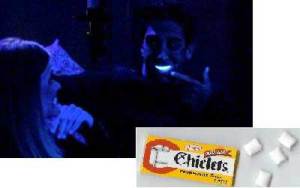 Healthy and natural, can quickly turn towards tacky, ‘Chiclet’ territory though. Remember the ‘Friends’ episode with Ross and his glow in the dark teeth?
Healthy and natural, can quickly turn towards tacky, ‘Chiclet’ territory though. Remember the ‘Friends’ episode with Ross and his glow in the dark teeth?
So what is the rule of thumb for teeth whitening?
The ideal shade of white really depends on personal preference. However, to retain that natural look, the whiteness of your teeth should not exceed the shade of the whites of your eyes (in most people). This allows you to have a nice bright smile without looking over-whitened. here are many options for teeth bleaching available. Finding the right method for you that will provide you with a beautiful, natural smile can be a daunting task.
here are many options for teeth bleaching available. Finding the right method for you that will provide you with a beautiful, natural smile can be a daunting task.
Before beginning any whitening procedure, consult your dentist first, to confirm which method is best for you.
]]> Watch any movie or television show and what do you see?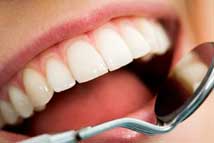 Perfect, straight, and unbelievably white smiles.
I’m not saying these types of smiles don’t occur naturally…however, often times in the media world you are looking at veneered, whitened, and orthodontically treated smiles. If you’re looking to replicate what you see in the media, here is some useful information on how to get your perfect smile.
There are many different ways to achieve your perfect look but before you start any work, the first step is to have a clear idea of what exactly you want to change. Is your smile too dark? Do you hate the way one of your teeth tilts? Is it the shape of your teeth you want to be different? Or the spaces in between them?
It is important to know where you want to go with your treatment so that you can pick the best type of treatment possible. Many of our patients come in and declare, “I want veneers.” While they think they need veneers, they may only require a non-invasive treatment such as Invisalign or teeth whitening to achieve the desired result. Therefore, it’s best to express your goal to your dentist and be open to different options he/she may suggest to get you there.
Veneers are a great aesthetic tool that can dramatically change a smile. However, veneers are a permanent restoration and require special care to keep them looking pristine. Maintenance should be taken into account before beginning treatment. Click here to learn more about the veneer process.
The decision to have porcelain veneers made is an important one. Veneers can provide a dramatic, beautiful, and realistic change to your smile. Once completed, most veneer restorations require special care and may have to be replaced after a 5-10 year period. In order to retain that look, you should take extra care to protect them from chips and decay.
To learn more about how to protect and maintain a healthy smile click here.]]>
Perfect, straight, and unbelievably white smiles.
I’m not saying these types of smiles don’t occur naturally…however, often times in the media world you are looking at veneered, whitened, and orthodontically treated smiles. If you’re looking to replicate what you see in the media, here is some useful information on how to get your perfect smile.
There are many different ways to achieve your perfect look but before you start any work, the first step is to have a clear idea of what exactly you want to change. Is your smile too dark? Do you hate the way one of your teeth tilts? Is it the shape of your teeth you want to be different? Or the spaces in between them?
It is important to know where you want to go with your treatment so that you can pick the best type of treatment possible. Many of our patients come in and declare, “I want veneers.” While they think they need veneers, they may only require a non-invasive treatment such as Invisalign or teeth whitening to achieve the desired result. Therefore, it’s best to express your goal to your dentist and be open to different options he/she may suggest to get you there.
Veneers are a great aesthetic tool that can dramatically change a smile. However, veneers are a permanent restoration and require special care to keep them looking pristine. Maintenance should be taken into account before beginning treatment. Click here to learn more about the veneer process.
The decision to have porcelain veneers made is an important one. Veneers can provide a dramatic, beautiful, and realistic change to your smile. Once completed, most veneer restorations require special care and may have to be replaced after a 5-10 year period. In order to retain that look, you should take extra care to protect them from chips and decay.
To learn more about how to protect and maintain a healthy smile click here.]]>
Do you have a function to go to and not enough time for teeth whitening? Here are 4 tips for faking it:
1. Wear red lipstick. 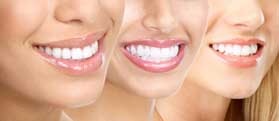 This is a trick seen often in dental advertisements. You may have noticed, women always have red hued lip color on. The contrast of your lip color and the red shade helps make your teeth appear lighter and brighter. If red’s not your color, then try to avoid wearing lipsticks that have a yellow or orange tone to them because they can give your teeth a yellow hue. Also, avoid pale or frosted shades and matte finishes, as they tend to make teeth look dull.
2. It’s all about the outfit! Try to avoid wearing bright white clothes.If you want to wear white, try picking a white that is off-white, cream or at least a shade lighter than your teeth. It will give the illusion that your teeth are whiter than they are, simply by comparison.
3. To make your teeth really pop, try using bronzer. Tan, golden, and darker skin tones make teeth appear whiter. By using a bronzer, with an appropriate lip color, you can make your smile appear brighter.
4 . And lastly, accessorize, accessorize, accessorize! Try wearing jewelry with a little sparkle to it such as silver, sparkling crystals or rhinestones. Avoid wearing gold which can emphasize yellow tones in teeth.Of course these are only a temporary fixes. For a truly dazzling white smile, speak with your dentist for recommendations on the best way to whiten your teeth.]]>
This is a trick seen often in dental advertisements. You may have noticed, women always have red hued lip color on. The contrast of your lip color and the red shade helps make your teeth appear lighter and brighter. If red’s not your color, then try to avoid wearing lipsticks that have a yellow or orange tone to them because they can give your teeth a yellow hue. Also, avoid pale or frosted shades and matte finishes, as they tend to make teeth look dull.
2. It’s all about the outfit! Try to avoid wearing bright white clothes.If you want to wear white, try picking a white that is off-white, cream or at least a shade lighter than your teeth. It will give the illusion that your teeth are whiter than they are, simply by comparison.
3. To make your teeth really pop, try using bronzer. Tan, golden, and darker skin tones make teeth appear whiter. By using a bronzer, with an appropriate lip color, you can make your smile appear brighter.
4 . And lastly, accessorize, accessorize, accessorize! Try wearing jewelry with a little sparkle to it such as silver, sparkling crystals or rhinestones. Avoid wearing gold which can emphasize yellow tones in teeth.Of course these are only a temporary fixes. For a truly dazzling white smile, speak with your dentist for recommendations on the best way to whiten your teeth.]]>
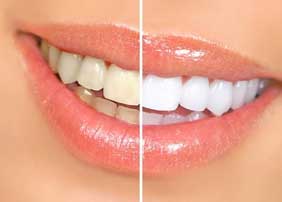
Myth #1: Whitening systems that use a laser are the best way to whiten teeth
Truth: This is a tricky subject. The term ‘laser’ is used for certain whitening systems. The ‘laser’ part of the In-Office whitening process is typically an ultraviolet light or a mercury metal halide light. These lights are a wavelenth that is in or near the visible light spectrum. To put it more simply, these lasers are more akin to heavy duty lightbulbs than the heavy duty lasers we have come to use in other aspects of dentistry. It is in my opinion that the term ‘laser’ although technically true, is used instead of UV light or mercury metal halide light because it sounds more impressive, high tech, and increases patient acceptibility of the procedure. The theory behind the ‘laser’ is that it activates the whitening gel and enhances the effects. However, many research articles show that the ‘laser’ works primarily by dehydrating the teeth whichmakes them appear whiter temporarily. And, as the teeth rehydrate, the shade evens out giving a result similar to other bleaching materials. Studies also have shown that this process can increase tooth sensitivity in the process and may actually decrease the whitening effect. I have used systems with and without the ‘laser’ and in my opinion I find that overall patient satisfaction is greater when we DO NOT use the ‘laser’.Myth #2: Certain name brand whitening systems are better than others
Truth: There are many whitening systems on the market and based on my experience in prescribing and using many of these products, I find that the major differences in whitening systems is the concentration of peroxide and whether the aformentioned ‘laser’ is used to enhance the effects. This is the breakdown of whitening materials: over-the-counter whitening systems cannot contain more than 10% carbamide peroxide (which is the active whitening agent) and In-Office whiteners can have a concentration from between 15-35%. The percentage of carbamide peroxide in In-Office whiteners depends on the company and the light used to enhance results is, as we mentioned before, up for debate. All whitening systems will result in whiter teeth (if you are a good candidate for teeth whitening). The difference is the length of time needed to achieve that result and the amount of sensitivity caused as a side effect. The higher the concentration of carbamide peroxide the faster you will see results.
Myth #3: In-Office teeth whitening takes 1 hour or less
Truth: I guess if you started the clock after…. #1. completing your medical history, #2. Examination of your teeth for restorations and cavities, #3. Polishing your teeth before placing whitening gel, #4. Placing the barriers on your gums and finally, #5. Applying the whitening gel… then maybe it would be an hour or less. Logistically, from the second you sit in the dental chair and begin the whitening process it takes about 2 hours from start to finish. Although, the actual amount of time that the gel is in contact with your teeth would be 45 minutes to an hour.
Myth #4: Your teeth will lighten 10 shades in one hour or less
Truth: This might be true if your teeth are the color mocha. In reality, the majority of peoples teeth are in the middle of the shade spectrum and do not see a drastic result such as 10 shades lighter. A realistic expectation would be 4-6 shades lighter for the average individual in one whitening sitting. 4-6 shades lighter when an individual starts in the middle of the shade spectrum will produce an outstanding, natural looking whitening result.
Myth #5: After I have my teeth whitened my teeth will be sensitive forever
Truth: The most commonly observed side effects of professionally applied peroxide products are temporary tooth sensitivity and the occasional irritation of gum tissues. Irritation of the gum tissue occurs when it is not correctly covered with a barrier material during the whitening process. Regarding the teeth, transient mild to moderate tooth sensitivity can occur in up to two-thirds of people during and after whitening treatment (which can last about 1-2 days). Sensitivity is generally related to the peroxide concentration of the material and the contact time (the stronger the concentration of peroxide and the longer applied, the more sensitivity). This is most likely the result of the easy passage of the peroxide through intact enamel and dentin to the nerve during a treatment interval. However, there have been no reported long-term adverse nerve problems when proper techniques are employed. The incidence and severity of tooth sensitivity may depend on the quality of the whitening material, the techniques used, and an individual’s response (genetics) to the whitening treatment methods and materials.
Myth #6: If I whiten my teeth too many times the enamel will become weaker
Truth:There have been reports of enamel damage to teeth, but apparently associated with the use of OTC whitening products. This damage may be related to the low pH (acidic) of the products and their overuse. Acids and tooth enamel do not mix well, often leading to tooth damage. A whitening gel should be as close to neutral on the pH scale as possible. A lot of science goes into the manufacturing of whitening products to control the pH and produce an effective gel, be very cautious of an unknown OTC whitening product. The take home point is, whether you are using OTC or professional grade whitening products, stick to whitening products of companies with good reputations and have professional supervision throughout the process.
Myth #7: After I whiten my teeth I will have to drink coffee and red wine through a straw otherwise my teeth will stain
Truth:You should stay away from dark beverages for the first two days after whitening because teeth are penetrable to stain. Your saliva has minerals in it that plug tubes leading from outside the tooth to the inside. The whitening process dissolves these plugs, leading to a tooth easily penetrable. Once the saliva reforms these plugs (~2 days) it is safe to drink dark beverages in moderation without consequence. As a side note, I myself am guilty of breaking the 2 day rule and have seen minimal stain relapse as a consequence.]]>
Myth #3: In-Office teeth whitening takes 1 hour or less
Truth: I guess if you started the clock after…. #1. completing your medical history, #2. Examination of your teeth for restorations and cavities, #3. Polishing your teeth before placing whitening gel, #4. Placing the barriers on your gums and finally, #5. Applying the whitening gel… then maybe it would be an hour or less. Logistically, from the second you sit in the dental chair and begin the whitening process it takes about 2 hours from start to finish. Although, the actual amount of time that the gel is in contact with your teeth would be 45 minutes to an hour.Myth #4: Your teeth will lighten 10 shades in one hour or less
Truth: This might be true if your teeth are the color mocha. In reality, the majority of peoples teeth are in the middle of the shade spectrum and do not see a drastic result such as 10 shades lighter. A realistic expectation would be 4-6 shades lighter for the average individual in one whitening sitting. 4-6 shades lighter when an individual starts in the middle of the shade spectrum will produce an outstanding, natural looking whitening result.Myth #5: After I have my teeth whitened my teeth will be sensitive forever
Truth: The most commonly observed side effects of professionally applied peroxide products are temporary tooth sensitivity and the occasional irritation of gum tissues. Irritation of the gum tissue occurs when it is not correctly covered with a barrier material during the whitening process. Regarding the teeth, transient mild to moderate tooth sensitivity can occur in up to two-thirds of people during and after whitening treatment (which can last about 1-2 days). Sensitivity is generally related to the peroxide concentration of the material and the contact time (the stronger the concentration of peroxide and the longer applied, the more sensitivity). This is most likely the result of the easy passage of the peroxide through intact enamel and dentin to the nerve during a treatment interval. However, there have been no reported long-term adverse nerve problems when proper techniques are employed. The incidence and severity of tooth sensitivity may depend on the quality of the whitening material, the techniques used, and an individual’s response (genetics) to the whitening treatment methods and materials.Myth #6: If I whiten my teeth too many times the enamel will become weaker
Truth:There have been reports of enamel damage to teeth, but apparently associated with the use of OTC whitening products. This damage may be related to the low pH (acidic) of the products and their overuse. Acids and tooth enamel do not mix well, often leading to tooth damage. A whitening gel should be as close to neutral on the pH scale as possible. A lot of science goes into the manufacturing of whitening products to control the pH and produce an effective gel, be very cautious of an unknown OTC whitening product. The take home point is, whether you are using OTC or professional grade whitening products, stick to whitening products of companies with good reputations and have professional supervision throughout the process.Myth #7: After I whiten my teeth I will have to drink coffee and red wine through a straw otherwise my teeth will stain
Truth:You should stay away from dark beverages for the first two days after whitening because teeth are penetrable to stain. Your saliva has minerals in it that plug tubes leading from outside the tooth to the inside. The whitening process dissolves these plugs, leading to a tooth easily penetrable. Once the saliva reforms these plugs (~2 days) it is safe to drink dark beverages in moderation without consequence. As a side note, I myself am guilty of breaking the 2 day rule and have seen minimal stain relapse as a consequence.]]>Frangella Dental
Offering advanced techniques in Cosmetic and General Dentistry in New York City.
200 W. 57th Street, Suite 1405
New York, NY 10019
(212) 245-2888
care@drfrangella.com




